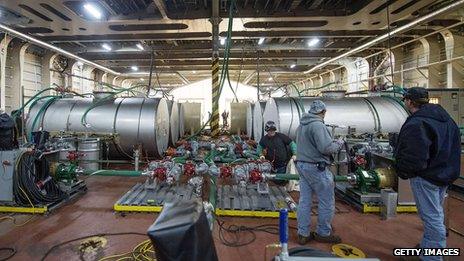Syria chemical weapons removal plan
- Published
The Joint Mission of the Organisation for the Prohibition of Chemical Weapons (OPCW) and the United Nations has outlined its plans, external for the destruction of Syria's chemical weapons.
The UN Security Council issued a resolution, external calling for the complete elimination of its chemical arsenal by 30 June 2014 after Syria agreed to join the Chemical Weapons Convention (CWC) in September.
It came after rockets filled with the nerve agent sarin were fired at towns in the Ghouta agricultural belt around Damascus on 21 August, killing hundreds of people. Western powers said only the government could have done it, but President Bashar al-Assad blamed rebels.
How the plan will unfold

1. The Syrian authorities are responsible for packing and safely transporting the chemical weapons from 12 sites across the country to the port of Latakia. Russia has supplied large-capacity and armoured lorries, while the US has sent container drums and GPS locators.
2. Russia is providing security for loading operations at Latakia, for which the US has supplied loading, transportation and decontamination equipment. China has sent 10 ambulances and surveillance cameras, and Finland an emergency response team in case of accidents.
3. Denmark and Norway are providing cargo ships and military escorts to take the chemicals to the container port of Gioia Tauro in Italy. Russia and China are also providing naval escorts and the first consignment of 16 tonnes left Latakia on 7 January.
4. In Italy, the "most critical" chemical agents will be loaded onto the US Maritime Administration cargo ship, MV Cape Ray, to be destroyed by hydrolysis in international waters. Less-toxic chemicals will be shipped by Norwegian and Danish vessels for disposal at commercial facilities.

Hydrolysis units to neutralise the chemical agents are being installed on the US ship MV Cape Ray